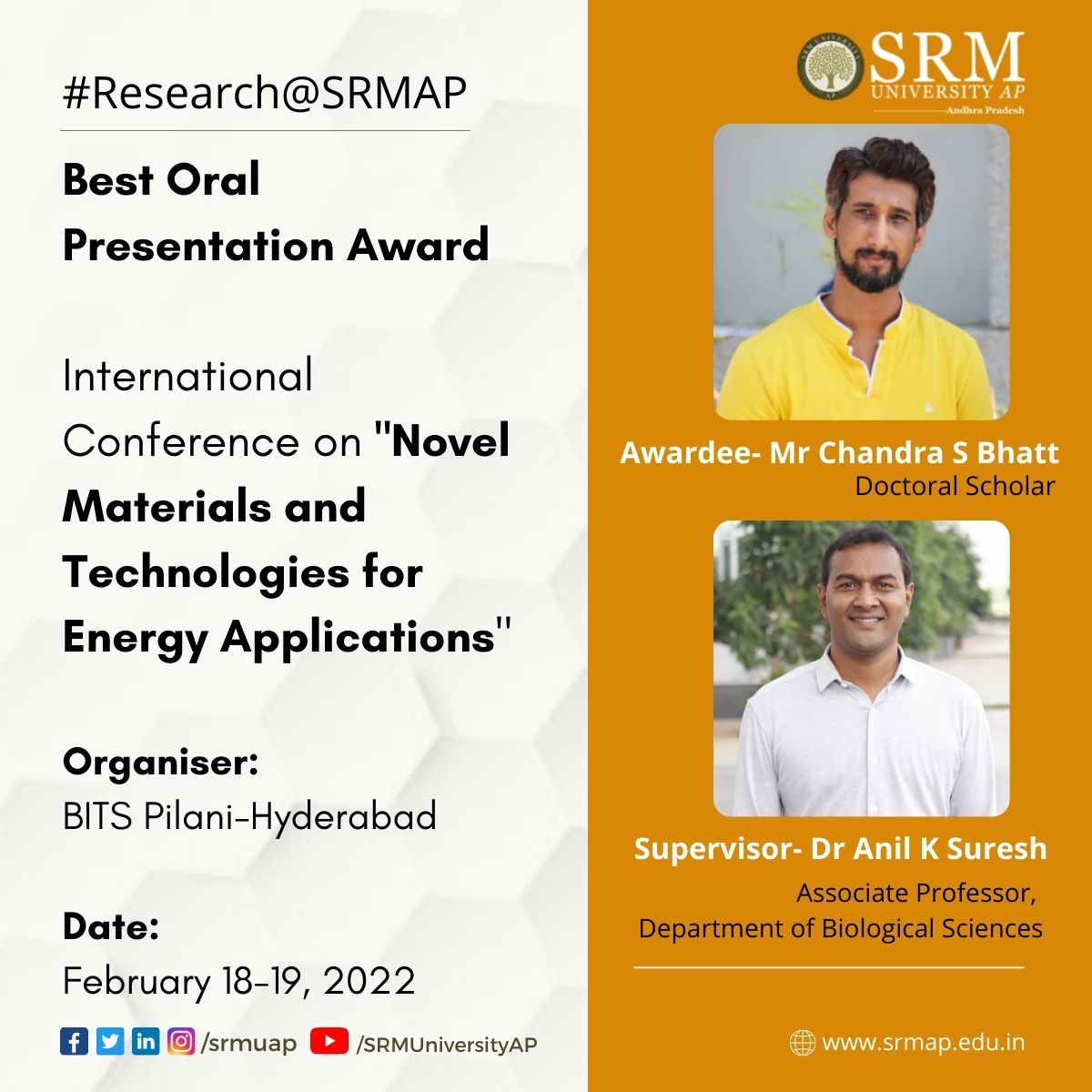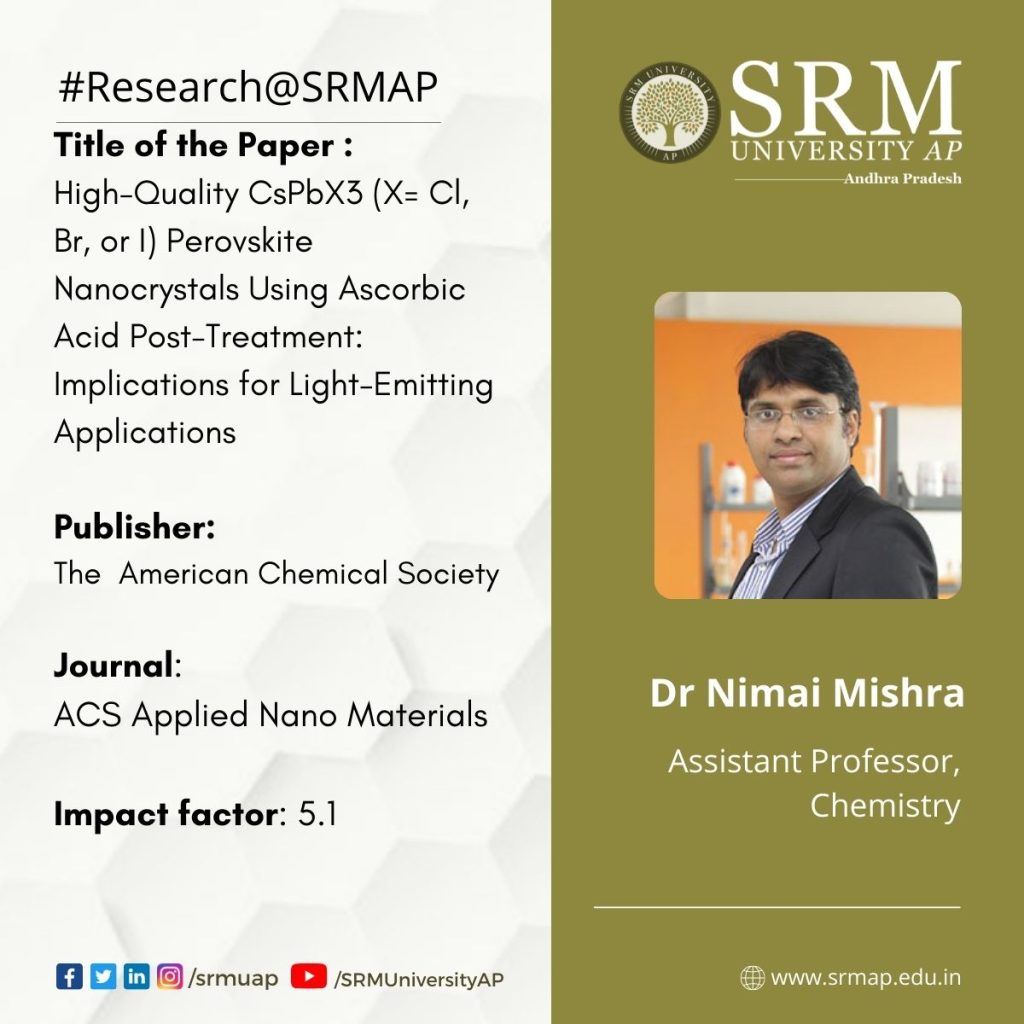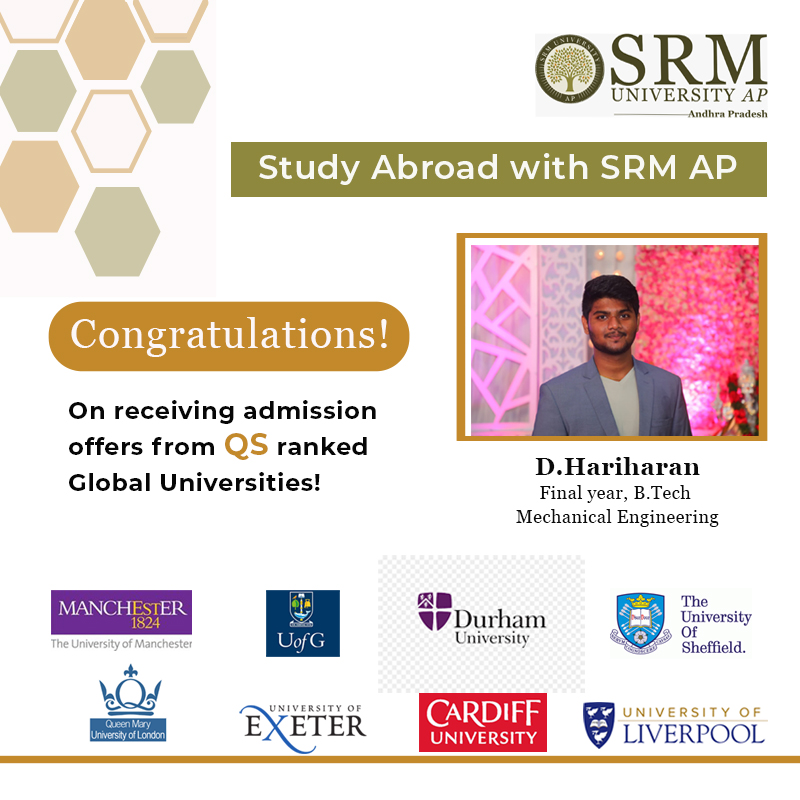Civil engineering student secures admission to multiple universities abroad
 In recent years, the number of Indian students enrolling in colleges abroad has increased. The competition to secure a seat in a world-class university also increases with the number of students aspiring for higher education. The office of International Relations and Higher Studies at SRM University-AP ensures that our students are admitted to QS ranked universities, not just one but many. Satya Narayana Reddy Kovvuri, final year student from the Department of Civil Engineering has received admission offers from New York University, Stevens Institute of Technology, University of North Carolina Charlotte, University of Houston, Arizona State University, and the University of Texas Arlington.
In recent years, the number of Indian students enrolling in colleges abroad has increased. The competition to secure a seat in a world-class university also increases with the number of students aspiring for higher education. The office of International Relations and Higher Studies at SRM University-AP ensures that our students are admitted to QS ranked universities, not just one but many. Satya Narayana Reddy Kovvuri, final year student from the Department of Civil Engineering has received admission offers from New York University, Stevens Institute of Technology, University of North Carolina Charlotte, University of Houston, Arizona State University, and the University of Texas Arlington.
Read this exclusive interview with Satya Narayana and get inspired!
How do you feel about the admission offers and the scholarship?
I applied to 9 universities, and I was not confident about the admissions because of the high intake. The first university I got the offer from was Stevens institute of technology. Then I gained confidence that I could make it into my desired university. Later I was overwhelmed by the admits that I secured and even a scholarship to NYU. Among the 9 Universities I applied to, I received admission offers from Stevens Institute of Technology, University of North Carolina Charlotte, New York University, University of Houston, Arizona State University and the University of Texas Arlington. I’m also eagerly waiting to hear from Kent State University, Clemson University and the University of Washington.
Selection process of universities you are admitted to
The Selection process is almost the same for all the universities I applied to. After submitting the application, the documents go for the department (of the selected course) review, and the selection criteria will be based on:
- Good GRE and English Proficiency test score(IELTS/TOEFL/DUOLINGO)
- A good CGPA with no backlogs.
- An efficient SOP that describes your qualities, achievements and skills.
- Strong LORs from professors.
- Research Papers / Publications(if any)
Within two months, the universities will inform us of the decision and the details of the scholarship if we are qualified. I have received a scholarship of $9000 per year from New York University, which is ranked 42 in the QS global ranking.
About the course that you have decided to enrol in
The course that I have decided to pursue is an MS in Construction Management. As I am keenly interested in the construction sector and my bachelor’s degree is in Civil Engineering, I decided to gain more knowledge and experience in the same field. The opportunity to study Construction Management course is my dream come true.
Support from SRM AP (Faculty, mentors etc.)
Dr Uma Maheshwar Arepalli, Assistant Professor in the Department of Civil Engineering is specialised in Transportation Engineering. He provided me with a few insights about courses and the colleges which are suitable for my specialisation. It helped me clear my confusion while I was applying for universities. Dr Bhagath Singh, Head of the Civil Engineering department, also guided me in this process. I followed his instructions on how to apply to universities abroad. The Academic affairs department also helped me by providing transcripts and certificates as soon as I approached them so that there is no delay in my application process.
Your message to junior batches
I advise my juniors to start the process as early as possible. Score high in the GRE (310 -325) and IELTS (6.5 – 8)tests. Search for the universities that provide the best coursework for your desired branch. Also, keep in mind the states you choose in the US provide job opportunities after you complete graduation. Lastly, choose the better states by thinking about living expenses and weather conditions. Check for the requirements of your targetted universities beforehand and draft an excellent personal statement. Submit the applications before priority deadlines as it is crucial to secure scholarships. Check for regular updates in the mail and also in the university application portal.
- Published in CIVIL NEWS, Departmental News, International Relations, IR-News, News
SRMAP Scholar wins best oral presentation award in International Conference
 Mr Chandra S Bhatt, a PhD Scholar (CSIR-JRF) working under the guidance of Dr Anil K Suresh, Associate Professor, Department of Biological Sciences, has won the Best Oral Presentation Award at the International Conference on “Novel Materials and Technologies for Energy Applications,” organised by BITS Pilani-Hyderabad, on February 18-19, 2022. Prof Ashutosh Sharma, Former DST Secretary & Institute Chair Professor, IIT Kanpur, was the Chief Guest of the Conference.
Mr Chandra S Bhatt, a PhD Scholar (CSIR-JRF) working under the guidance of Dr Anil K Suresh, Associate Professor, Department of Biological Sciences, has won the Best Oral Presentation Award at the International Conference on “Novel Materials and Technologies for Energy Applications,” organised by BITS Pilani-Hyderabad, on February 18-19, 2022. Prof Ashutosh Sharma, Former DST Secretary & Institute Chair Professor, IIT Kanpur, was the Chief Guest of the Conference.
Abstract:
Mr Bhatt’s project aims to develop the best out of waste, which is practically demonstrated by synthesising gold nanostructured eggshell-based supported catalyst. Besides this novel strategy, the megacatalyst is implemented in the real-time degradations of organic and sewage dyes that are harmful to the environment and hydrogenation of nitroarenes at gram-scale (precursors for various pharmaceutical ingredients). Our rationale, naturally created, stable, reusable, hand-removable, resilient catalyst developed from left-over food waste trounces the majority of the existing challenges while utilising nano-based catalysts for heterogeneous catalysis.
With this innovation, Mr Bhatt aims to demonstrate pilot-scale (100-1000 litre) batch catalytic reactions for real-time textile sewage dye detoxification and gram scale hydrogenation of pharma-precursor for the production of acetaminophen, as a step of validation for immediate technology transfer and commercialisation for both environmental remediation and active pharmaceutical ingredients (API’s).
About the Author:
Mr Bhatt aims to continue his scientific career as a prominent scientist in the interdisciplinary area of nano-immunology for cancer theragnostics. Therefore, after the completion of his PhD, he wishes to advance his research career to contribute further to the realm of science upon postdoctoral training from a top-ranking institution abroad.
“It is indeed a moment of pride for me to be awarded the Best Oral Presentation Award in an International Conference organised by BITS Pilani, Hyderabad, winning over 30 participants across the Nation. I express my heartfelt gratitude to my supervisor Dr Anil K Suresh, for his guidance and motivation me throughout the journey,” said Mr Bhatt.
While expressing his joy, Dr Suresh emphatically said, “This was his first oral presentation in an International Conference, and he was conferred with the “Best Oral Presentation” Award. This recognition speaks for Chandra Sekhar’s dedication to his research. He has been working enthusiastically on this project, and I wish that the paper gets published in a high-impact journal which has already been communicated for Shekar’s bright scientific career.”
- Published in Biology News, News, Research News, Students Achievements
High-quality perovskite nanocrystals for light-emitting applications
 Dr Nimai Mishra, Assistant Professor, Department of Chemistry, SRM University-AP, Andhra Pradesh, along with his research group comprising of students pursuing PhD under his supervision, Ms VG Vasavi Dutt, Mr Syed Akhil, Mr Rahul Singh, and Mr Manoj Paalabathuni have published a research article titled “High-Quality CsPbX3 (X = Cl, Br, or I) Perovskite Nanocrystals Using Ascorbic Acid Post-Treatment: Implications for Light-Emitting Applications” in the Journal “ACS Applied Nano Materials” (published by The American Chemical Society) having an impact factor of ~5.1.
Dr Nimai Mishra, Assistant Professor, Department of Chemistry, SRM University-AP, Andhra Pradesh, along with his research group comprising of students pursuing PhD under his supervision, Ms VG Vasavi Dutt, Mr Syed Akhil, Mr Rahul Singh, and Mr Manoj Paalabathuni have published a research article titled “High-Quality CsPbX3 (X = Cl, Br, or I) Perovskite Nanocrystals Using Ascorbic Acid Post-Treatment: Implications for Light-Emitting Applications” in the Journal “ACS Applied Nano Materials” (published by The American Chemical Society) having an impact factor of ~5.1.
Abstract:
Cesium lead halide perovskite nanocrystals (CsPbX3 PNCs) have been the flourishing area of research in the field of photovoltaic and optoelectronic applications because of their excellent optical and electronic properties. However, they suffer from low stability and deterioration of photoluminescence (PL) properties post-synthesis. One of the ways to minimize the surface defects in the surface treatment with suitable ligands is to achieve the PNCs with superior PL properties for light-emitting applications.
In this article, Dr Mishra’s research group addressed the issue of stability in PNCs. We demonstrate to achieve high photoluminescence and stability of CsPbX3 PNCs by incorporating ascorbic acid via post-treatment as a new capping ligand that is abundantly available. Upon addition of ascorbic acid as surface passivation ligand into the oleic acid/oleylamine system to get near-unity photoluminescence quantum yield (PLQY) of CsPbBr3, CsPb(Br/I)3, and for CsPbI3 perovskite NCs. Maintaining stability has become the hotspot of research in this field. Hence, as-a-proof of concept, the stability studies of PNCs in ambient conditions, under continuous UV irradiation, and PL with temperature variations are put forth here. The stability enhancement with post-treatment of ascorbic acid is highly reproducible as we tested for four batches of samples.
Despite the significant advancements of PNCs, there is a challenge afflicting the stability of CsPbI3 PNCs. They are thermodynamically unstable and undergo a non-perovskite phase (δ-phase) transition at room temperature. Many efforts have been reported in the stabilization of iodide perovskite NCs by critically passivating PNCs and applying them for optoelectronics and photovoltaics. On the other hand, mixed halide perovskites like CsPbBrI2 which are relatively stable than CsPbI3 PNCs are a better choice for device applications. But, photo-induced halide segregation is unavoidable which in turn again limit their usage in practical applications. In this manuscript, we demonstrated that the ultra-stable iodide-based PNCs can be achieved by simple and facile surface treatment with ascorbic acid.
The PL intensity of untreated and ascorbic acid-treated PNCs is recorded for 42 days since the date of synthesis. The measurements are carried out for 4 different batches of samples to ensure reproducibility. It is found that the PL intensity is deteriorating rapidly for untreated PNCs while the PL intensity is largely maintained for ascorbic acid treated PNCs. Nearly ̴72% of the initial PL intensity is maintained even after 42 days for the ascorbic acid-treated CsPbBr3 PNCs while the PL intensity is dropped to 24% for untreated PNCs. Ascorbic acid treated CsPbBrI2 PNCs exhibited exceptional ambient stability where ̴69% of the initial PL intensity is maintained after 42 days while the PL of untreated CsPbBrI2 PNCs is degraded rapidly within 2 weeks from the date of synthesis. Moreover, the PL stability of CsPbI3 PNCs is high for ascorbic acid-treated samples even after 55 days while the PL has deteriorated within 4 days for untreated CsPbI3 PNCs. The PL of untreated CsPbI3 PNCs is completely lost in the first 4 hours of UV illumination while ̴ 76.7% remnant PL is observed for ascorbic acid-treated CsPbI3 PNCs. We believe the stabilization of CsPbX3 PNCs of different halide compositions via simple surface treatment with ascorbic acid could form a basis for futuristic light-emitting applications.
Read the full paper: https://pubs.acs.org/doi/full/10.1021/acsanm.1c04312
- Published in Chemistry-news, News, Research News
An incredible feat of Mechanical Engineering student

It is a moment of pride and celebration for the Department of Mechanical Engineering at SRM University-AP as Hariharan D, Final year, BTech Mechanical Engineering bags admission offers from multiple top-ranked overseas universities including the University of Manchester that ranks 27 in the QS World University Rankings.
Moulding up the students through the right training and plotting out the right pathway for them to scale further heights have always been the primary objective of the faculty of SRM University-AP. “Happy to hear that you got placed in a core dream company. I hope this will not dampen your aspirations to go for higher studies. Indeed, students like you should study as far as you can. You should bring more laurels to this institution and make us proud”, this was the message Hariharan received from his faculty mentor, Dr Pramod Jammy, which kindled his spirit to set off for higher studies abroad.
“I am ever grateful to my beloved faculty mentors, Dr Pramod Jammy, Dr Lakshmi Sirisha and Dr Surfaraz Halkarni, for their constant support, inspiration and Letter of Recommendations provided amidst their busy schedules. I also thank my Department Head, Dr Prakash Jadhav, for his continuous motivation”, remarked Hariharan.
According to him, creating an imposing CV and impactful SoP is the deciding factor of the application process. He expressed his gratitude to the entire department for their effective involvement in every bit of the application process. “To build an attractive SoP and resounding CV, we need credentials like decent CGPA, involvement in departmental activities such as webinars, internships, workshops, minor projects, software skills, etc. Also, the close association with the department faculties right from the first year is essential to get their affinity and the commendable Letter of Recommendations” he added.
Forging a conducive platform to actualize one’s potential and chase after the life of one’s dreams is what makes SRM University-AP the topmost priority of students. Hariharan has set out an ideal example for many to follow and believe in their dreams coming true with SRM University- AP.

